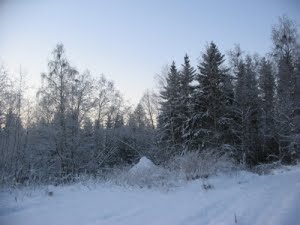The ozone hole that formed in the stratosphere over Antarctica in the 1970s was a classic example of an environmental tipping point.
Ozone-destroying chemicals built up in the frigid stratosphere until they abruptly - and unexpectedly - caused the ozone layer over the Antarctic to shift into a new state, with ozone all but absent in the spring. Nobody saw it coming, as nobody understood at the time that the chemistry of polar stratospheric clouds makes ozone-destroying chemicals more potent, leading to runaway ozone destruction.
The primary cause of ozone depletion is the presence of chlorine-containing source gases (primarily CFCs and related halocarbons). In the presence of UV light, these gases dissociate, releasing chlorine atoms, which then go on to catalyze ozone destruction. The Cl-catalyzed ozone depletion can take place in the gas phase, but it is dramatically enhanced in the presence of polar stratospheric clouds (PSCs).
These polar stratospheric clouds (PSC) form during winter, in the extreme cold. Polar winters are dark, consisting of 3 months without solar radiation (sunlight) and the low temperatures form cloud particles.
The world acted quickly to heal the hole. With most of the culprit chemicals now banned, the worst of the danger has passed. It is not over entirely, however. One concern is global warming. Trapping more heat close to the Earth's surface leaves the stratosphere colder. This means that the Arctic stratosphere could get cold enough in coming years for the remaining ozone-eating chemicals in the atmosphere to open up an ozone hole over the northern continents.
Away from the poles we look safe, unless there is some unknown quirk of atmospheric chemistry waiting to trip us up. Rockström and Paul Crutzen of the Potsdam Institute for Climate Impact Research in Germany recommend preventing stratospheric ozone concentrations outside the polar regions from falling by more than 5 per cent, or below a global average of 276 Dobson units (a measurement of the density of stratospheric ozone). With the concentrations of ozone-eaters still falling, it seems likely that we will stay within this planetary boundary.


Satellite instruments provide us with daily images of ozone over the Antarctic region. The ozone hole image below shows the very low values (blue and purple colored area) centered over Antarctica on October 4, 2004. From the historical record we know that total column ozone values of less than 220 Dobson Units were not observed prior to 1979. From an aircraft field mission over Antarctica we also know that a total column ozone level of less than 220 Dobson Units is a result of catalyzed ozone loss from chlorine and bromine compounds.
The ozone hole is the region over Antarctica with total ozone of 220 Dobson Units or lower. This map shows the ozone hole on October 4, 2004. The data were acquired by the Ozone Monitoring Instrument on NASA’s Aura satellite.
Consequences of ozone layer depletion
Since the ozone layer absorbs UVB ultraviolet light from the Sun, ozone layer depletion is expected to increase surface UVB levels, which could lead to damage, including increase in skin cancer. This was the reason for the Montreal Protocol. Although decreases in stratospheric ozone are well-tied to CFCs and there are good theoretical reasons to believe that decreases in ozone will lead to increases in surface UVB, there is no direct observational evidence linking ozone depletion to higher incidence of skin cancer in human beings. This is partly because UVA, which has also been implicated in some forms of skin cancer, is not absorbed by ozone, and it is nearly impossible to control statistics for lifestyle changes in the populace.
Increased UV
Ozone, while a minority constituent in the Earth's atmosphere, is responsible for most of the absorption of UVB radiation. The amount of UVB radiation that penetrates through the ozone layer decreases exponentially with the slant-path thickness/density of the layer. Correspondingly, a decrease in atmospheric ozone is expected to give rise to significantly increased levels of UVB near the surface.
Biological effects
The main public concern regarding the ozone hole has been the effects of increased surface UV radiation on human health. Were the high levels of depletion seen in the ozone hole ever to be common across the globe, the effects could be substantially more dramatic.
Is there a connection between the ozone hole and global warming?
Our atmosphere is one connected system, it is not surprising that ozone depletion and global warming are related in other ways.
The thickness of the polar stratospheric ozone layer depends on the rate of production of ozone in the tropical stratosphere, the movement of ozone from the tropics to the poles, the amount of ultraviolet radiation from the Sun, the polar stratospheric cloud cover, and the chemical reactions between the ozone and ozone-depleting substances. Each of these factors might be affected by climate change.
Poleward motions in the stratosphere, which increase polar concentrations of ozone, as well as the strength of the polar stratospheric vortices, which decrease ozone via PSC formation, are both expected to increase as temperatures rise in the lower atmosphere.
Yet temperatures in the lower stratosphere are decreasing as a result of increased carbon and other heat-trapping emissions.
Cooling of the lower polar stratosphere enhances PSC formation, and thus contributes to ozone loss. It appears unlikely that the decrease in ozone-depleting substances will lead to restabilization of the pre-1980 stratospheric ozone layer because of the competing and uncertain effects of further climate change.




